
Medina is a village in the Towns of Shelby and Ridgeway in Orleans County, New York, United States. It is located approximately 10 miles south of Lake Ontario. The population was 6,065 at the 2010 census, making it the county's most populous municipality. The village was named by its surveyor, Ebenezer Mix. It is part of the Rochester Metropolitan Statistical Area. The Medina zip code, 14103, encompasses the village of Medina and the surrounding towns of Ridgeway and Shelby. The United States Census Bureau estimates the 2017 population of this area to be 17,234.

Sonnenberg Gardens and Mansion State Historic Park is a 50-acre (20 ha) state park located at 151 Charlotte Street in Canandaigua, New York, at the north end of Canandaigua Lake, in the Finger Lakes region of Upstate New York. The house and gardens are open to the public every day, May through October.

This is intended to be a complete list of properties and districts listed on the National Register of Historic Places in Orleans County, New York. The locations of National Register properties and districts may be seen in a map by clicking on "Map of all coordinates". Two listings, the New York State Barge Canal and the Cobblestone Historic District, are further designated a National Historic Landmark.

Belhurst Castle is a former private residence on the shores of Seneca Lake in Geneva, New York, United States. It was designed by architects Fuller & Wheeler and built between 1885 and 1889. The three-story, nine bay wide Romanesque Revival style mansion is constructed of Medina sandstone. It has a slate gable roof, one-story solarium, and four rectangular stone chimneys. It features projecting porches, bays, towers with conical and pyramidal roofs, eyebrow windows, and a porte cochere with Syrian arch.
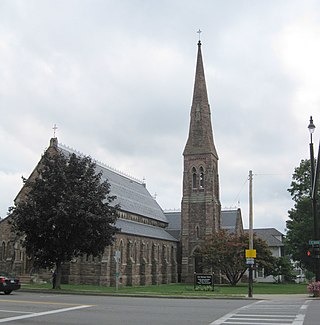
Zion Episcopal Church is a historic Episcopal church in Palmyra, Wayne County, New York. It was designed in a Late Gothic Revival style by Emlyn T. Littel and was built in 1872. It is built of Medina sandstone with limestone trim. Its roof features polychrome slate shingles.

The Main Street Historic District in Medina, New York, United States, is the downtown commercial core of the village. It is a 12-acre (4.9 ha) area stretching south along Main Street from the Erie Canal to the railroad tracks.
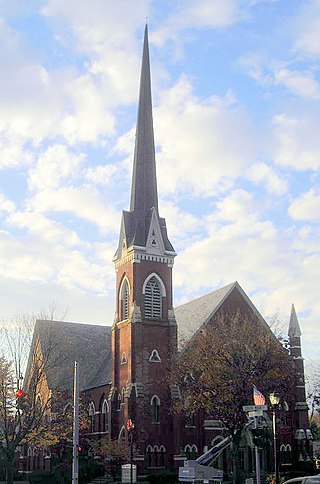
The First Baptist Church of Fairport is a historic Baptist church located at 94 South Main Street at Church Street in Fairport, Monroe County, New York. It was built in 1876, and is a 2+1⁄2-story, cruciform plan, High Victorian Gothic church. It is constructed of brick and rests on a Medina sandstone foundation. It has a large square corner tower topped by a tall narrow spire. It features ornamental stone trim, a steeply pitched gray slate roof, and 72 original stained, leaded glass windows. In 2006 a national drugstore tried to buy the land but, in response to adverse local reactions including a concert held by local youth musicians, money was raised to help repair the church instead.
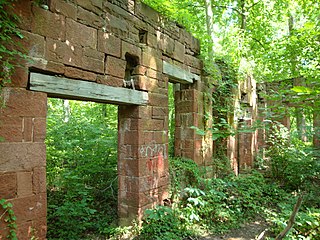
Seneca Quarry is a historic site located at Seneca, Montgomery County, Maryland. It is located along the Chesapeake and Ohio Canal on the north bank of the Potomac River, just west of Seneca Creek. The quarry was the source of stone for two Potomac River canals: the Patowmack Canal on the Virginia side of Great Falls; and the C&O Canal, having supplied red sandstone for the latter for locks 9, 11, 15 - 27, and 30, the accompanying lock houses, and Aqueduct No. 1, better known as Seneca Aqueduct, constructed from 1828 to 1833.

The Oak Hill Cemetery Chapel, also known as the Renwick Chapel or James Renwick Chapel, is a historic building in the Georgetown neighborhood of Washington, D.C., United States. Designed by James Renwick, Jr. in 1850, Oak Hill Cemetery Chapel is the architect's only known example of Gothic Revival church architecture in Washington, D.C. It is located on the highest ridge in Oak Hill Cemetery, near the intersection of 29th and R Streets NW. The chapel is one of two structures in Oak Hill Cemetery listed on the National Register of Historic Places, the other being the Van Ness Mausoleum. The chapel, mausoleum, and cemetery are contributing properties to the Georgetown Historic District, a National Historic Landmark.

Richmond Avenue Methodist-Episcopal Church, also known as Richmond Avenue United Methodist Church, is a historic Methodist Episcopal Church located at Buffalo in Erie County, New York. It consists of two structures: a rectilinear Chapel structure, which dates to 1885–1891, and a larger Temple structure dating to 1887–1898. Both structures are two and a half stories set on a raised basement story, with two three-story towers. They are built of ashlar Medina sandstone. It is now home to the Upper West Side Arts Center.

Connecticut Street Armory, also known as the 74th Regimental Armory, is a historic National Guard armory building located at Buffalo in Erie County, New York. It is sited at Columbus Park. It is a massive castle-like structure built in 1899 of Medina sandstone. It was designed by architect Isaac G. Perry. It consists of a 3+1⁄2-story administration building with an attached 2-story drill shed all constructed of sandstone, lying on a rusticated battered stone foundation. The building features 4- to 6-story towers surrounding the administration building, and a 6+1⁄2-story square tower at the center entrance. It is home to the 74th Regiment of the New York National Guard. Prior to its construction, the site was home to a 13.5 million gallon reservoir.

Millville Cemetery is located on East Shelby Road in Millville, New York, United States. It was established in 1871 as a rural cemetery, expanding on an early burial ground.
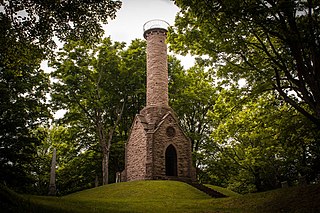
Mount Albion Cemetery is located on New York State Route 31 in the Town of Albion, New York, United States, east of the village of Albion, which owns and operates it. It is a rural cemetery established in the 1840s on a glacial drumlin.

The North Main–Bank Streets Historic District is located along those streets in Albion, New York, United States. It is one of two historic districts in the village, comprising the commercial core of the village, developed during its years as a major stop on the Erie Canal. A portion of the canal, now the New York State Barge Canal, and two of its bridges are within the district.

Presbyterian Church in New Scotland and the New Scotland Cemetery is a historic Presbyterian church and cemetery located in New Scotland in Albany County, New York. The church was built in 1849 and extended in 1868. It is a 2-story, three-bay-wide, rectangular frame structure with a 1+1⁄2-story front projecting vestibule / entrance block. It features a large, two-stage square central projecting tower. The education wing was completed in 1957. The cemetery includes about 500 burials dating from the 18th to 20th century. The congregation was founded in 1787 and the present structure is its second building.

The Shiloh Meeting House and Cemetery is a historic Presbyterian meeting house and cemetery located near Ireland in Madison Township, Dubois County, Indiana. It was built in 1849, and is a simple one-story, rectangular frame building with Greek Revival style design elements. It has a gable front roof and rests on a sandstone pier foundation. Also on the property is a contributing cemetery.

First Baptist Church is a historic Baptist church complex located at Brockport in Monroe County, New York. It was built between 1924 and 1929, and consists of a Collegiate Gothic–style church building with an attached Tudor Revival Social and Recreational wing. It measures 100 feet (30 m) wide and 140 feet (43 m) deep. The church is constructed of red brick with Norristone and Medina sandstone trim. It has a slate-covered gable roof and features engaged square towers flanking the main entrance. The Social and Recreational wing has a red brick first floor and half-timbered and stucco second story. It has Norristone trim and a hipped slate roof.
North Star School District No. 11, also known as the North Star History Center, is a historic one-room school building located at Hamlin, Monroe County, New York. It was built in 1844, and is a one-story, Greek Revival style brick building. It rests on a Medina sandstone foundation and has a front gable roof with a prominent cornice and topped by a bell tower. It has a front porch added in 1912 and rear frame additions added about 1952. Also on the property are two contributing wooden privies and a coal house. The school closed in 1952, and subsequently used as a community center and local history museum since 1987.
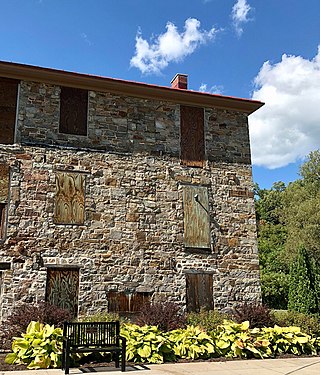
Heyworth–Mason Industrial Building is a historic factory located in Peru, Clinton County, New York. It was built in 1836, and is a three-story, seven bay, rectangular, sandstone building measuring 35 feet wide and 60 feet long. It has a gable roof and interior end chimneys. It originally housed a factory and later storage. It was converted to apartments in the 1970s.

Riverside Cemetery is a historic cemetery located near Lowman, Chemung, Chemung County, New York. It was established in the 1790s, and contains graves dating from then to the present. It has a cast iron gate archway inscribed "Riverside Cemetery" and dated to about 1900. The cemetery includes the graves of many early settlers and Revolutionary War soldiers. Notable burials include Lieutenant Governor Seymour Lowman (1868–1940).



























